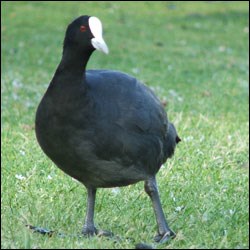
IntroductionAmerican coots are gregarious birds often seen in large rafts on the open water of lakes, marshes and larger rivers, especially during migration. These small, plump, duck-like birds feed by tipping up to reach tender vegetation on the bottom of a marsh. They may also dive as much as six feet to retrieve plant material and may even forage on land for seeds. They are, however, opportunistic and supplement their diet by mobbing ducks and stealing food that the larger birds have found. A pair of these interesting birds often build as many as nine nests on mats of floating vegetation anchored to reeds in shallow water, but the hen only lays eggs in one nest. The young are precocial, and are capable of leaving the nest shortly after hatching and following a parent through the wetland. The family may return to nursery nests to spend the night or during cold weather so the adults may brood the young. The plentiful coot nests may be appropriated by other open-water nesting ducks, such as canvasbacks or redheads, for their own use. Fascinating Facts
Identification
| |
Last updated: February 25, 2022
